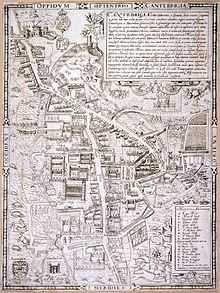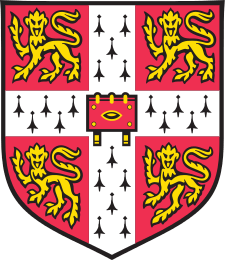St Edward's Passage
|
St Edward's Passage, looking from King's Parade to Peas Hill | |
| Maintained by | Cambridge City Council |
|---|---|
| Length | 145.40 m[1] (477.03 ft) |
| Location | Cambridge, England |
| Postal code | CB2 3PJ |
| Coordinates | 52°12′16″N 0°07′04″E / 52.2045°N 0.1178°ECoordinates: 52°12′16″N 0°07′04″E / 52.2045°N 0.1178°E |
| Construction | |
| Construction start | c. 13th century |
St Edward's Passage is a Y-shaped alleyway in Cambridge, England, situated between King's Parade – opposite the main gate of King's College – and Peas Hill. Excavations in 1995 indicated that it dates back to the 13th century.[2]
The passage is marked on Richard Lyne's map of the city from 1574, the earliest known map of Cambridge, and on John Hammond's from 1592.[3] Cambridge City Council writes that it is one of the few areas of Cambridge that illustrate the "cheek-by-jowl nature" of the early town.[2]
Overview
The entrance of the Church of St Edward King and Martyr, which also dates to the early 13th century, is located on St Edward's Passage. Its small churchyard lies between the two arms of the alley.[4]
Calling itself the cradle of the English Reformation – a period of religious upheaval in the 16th century, when the English Church opposed the authority of the Roman Catholic Church – the church still contains the original pulpit from which the Protestant reformers Robert Barnes (1495–1540), Thomas Bilney (1495–1531) and Hugh Latimer (1487–1555) preached.[4] During midnight mass in the church on 24 December 1525, Barnes, an Augustinian friar who became a Lutheran, gave the first sermon in which a reformer accused the Catholic Church of heresy.[5] Historian Alec Ryrie referred to it as "the first set-piece confrontation of the English Reformation."[6] Barnes, Bilney and Latimer were eventually burned at the stake.[7]
St Edward's Passage also houses the Cambridge Arts Theatre and the Venue (a restaurant) at no. 6, the Indigo Coffee House at no. 8, the Haunted Bookshop at no. 9, the Corpus Christi College Playroom (a theatre) at no. 10, student accommodation at nos. 12–15, and David's bookshop (established in 1896) at no. 16. Most of the buildings are from the late 18th and early 19th century, and several (nos. 3, 4, 8–10, 12–14, 15a and 16) are Grade II-listed buildings.[8]
-

St Edward's Passage (below centre) on Richard Lyne's map of 1574
-
Looking toward King's Parade and King's College
-
Cambridge Arts Theatre
-
St Edward King and Martyr churchyard
-
Looking toward David's bookshop; churchyard on the right
-
David's bookshop
-
the Haunted Bookshop
-
Looking toward King's Parade and King's College
-
Looking toward Peas Hill
See also
- Marian persecutions
- White Horse Tavern, Cambridge
References
- ↑ "List of streets", Cambridgeshire County Council, 1 December 2012, p. 17.
- ↑ 2.0 2.1 "Cambridge Historic Core Appraisal: St Edward's Passage", Cambridge City Council, June 2006, p. 2.
- ↑ J. Willis Clark, Old Plans of Cambridge, 1574-1798, Bowes & Bowes, 1921.
- "Unfolding landscapes", Cambridge University Library, 2003.
- ↑ 4.0 4.1 Geoffrey Dickens, English Reformation, Penn State Press, second edition, 1991, p. 91.
- ↑ "About St Edward's", St Edward King and Martyr.
- Korey Mass, The Reformation and Robert Barnes: History, Theology and Polemic in Early Modern England, Boydell & Brewer, 2010, pp. 1, 14.
- None of Barnes's sermons were preserved. See John Craig and Korey Maas, "A Sermon by Robert Barnes, c. 1535", The Journal of Ecclesiastical History, No. 55, 2004, pp. 542–551.
- ↑ Alec Ryrie, The Gospel and Henry VIII: Evangelicals in the Early English Reformation, Cambridge University Press, 2003, p. 170.
- ↑ Stephanie Boyd, The Story of Cambridge, Cambridge University Press, 2005, p. 36.
- Just before he was burned, in Broad Street, Oxford, Latimer famously said to a fellow reformer, Nicholas Ridley, who was also being burned: "Be of good comfort, Master Ridley, and play the man. We shall this day light such a candle by God's grace in England, as I trust shall never be put out."
- ↑ "Listed Buildings in Cambridge, Cambridgeshire, England", British Listed Buildings.
Further reading
- "Floor plan", student accommodation, St Edwards Passage, Annand and Mustoe Architects.
- Cargill Thompson, W. D. J. The Sixteenth-Century Editions of A Supplication unto King Henry the Eighth by Robert Barnes", Transactions of the Cambridge Bibliographical Society , Vol. 3, No. 2, 1960, pp. 133–142.
- Rex, Richard. The Early Impact of Reformation Theology at Cambridge University, 1521-1547. Reformation and Renaissance Review, No. 2, December 1999.
.jpg)








